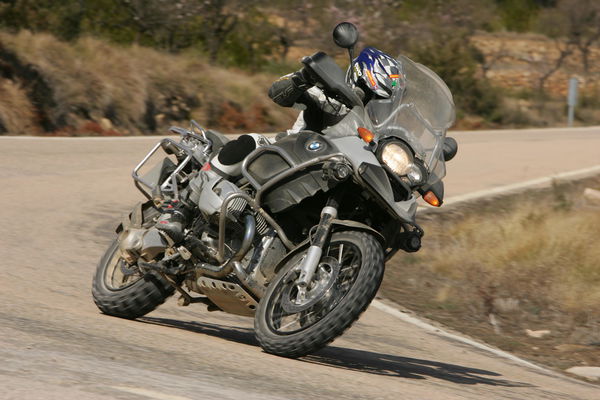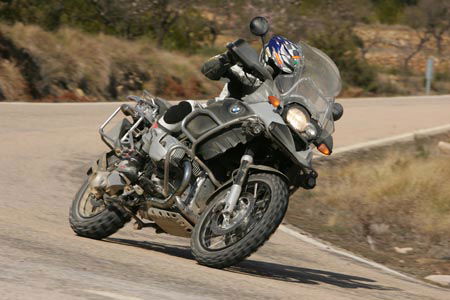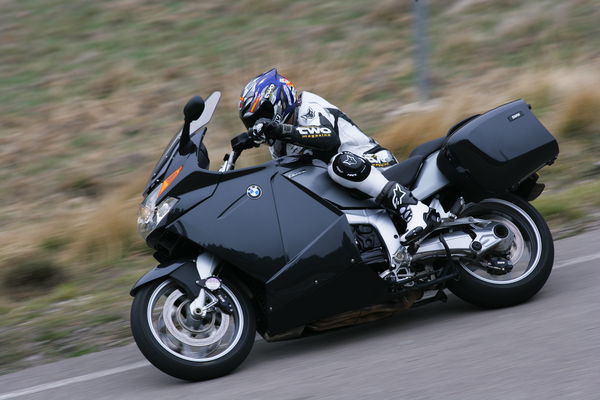First Ride: 2006 BMW R1200GS Adventure
If you fancy a lap of the planet put one of these on your shopping list. R1200GS gets the Adventure treatment

 |
There's no getting away from it: the BMW R1200GS Adventure is a man's bike. If you're a wimp you can forget it, it's not for you. With a dry weight of 220kg (250kg with fuel), a lofty seat height and mental Mad Max looks it was never going to be a runabout for Kylie, even if she could get it off the side-stand.
The off-road GS range has been a massive success for BMW both in competition and customer sales, so for 2006 the best-selling R1200GS is now available in Adventure guise.
The new GS wasn't built specifically to circumnavigate the globe, but its increased 33-litre, 465-mile fuel range alone means you'd struggle to find anything better should you be considering following in the wheel tracks of Ewan and Charley in the not-too-distant future.
My experience was a much more modest two days in the mountains north west of Valencia - the forests of Aras de los Olmos to be precise, and an excellent location to put the latest GS to the test.
The Adventure's rugged appearance suggests it means business, so if racking up miles at high speed on roads and loose trails is your bag then this beast is certainly built to deliver the goods.
There are many changes to the new Adventure over the standard GS, the most notable being more power from the 1200cc twin motor. It puts out a claimed 100bhp, with a 17 per cent increase in torque helping to keep gear changes to a minimum whether you're on- or off-road. The engine is pleasantly free revving, which means the rev limiter is never far away when traction is at a minimum and the rear tyre is free to spin. Throttle response and fuelling are difficult to fault, although a fair bit of popping occurs while shifting down through the lower gears.
Talking of shifting, the new six-speed gearbox is a big improvement on the old model as gear changes are now quicker and more positive. As is now the norm on many bikes, a gear position indicator is incorporated in the flat screen dash - very useful with such a flexible engine as it's easy to lose track of what gear you're in.
Spring travel front and rear is increased by 20mm to help with off-road handling, and the rear can be fine tuned with the big preload adjuster just under the seat. Through the forest trails the front Telelever and rear Paralever systems coped well, except over big jumps when they would bottom out. My only other problem was stopping for tight turns on loose surfaces. This was down to sheer weight, and something that can't be avoided no matter how good the suspension or tyres are.
There is much focus on the off-road riding element of the Adventure as the foot pegs are now wider and the gearshift, rear brake lever and seat height are adjustable. The gearshift was fine for me but I found the rear brake lever too low even at its maximum adjustment.
To keep damage to a minimum after the inevitable off-road tip-offs, new protection for the tank, engine and rocker covers has been added. Continental's Twinduros are fitted as standard on sturdy cross spoke wheels but, as with all trail bike tyres, they are a compromise. Considering the Adventure's size and weight I was impressed by its hill climbing potential and awesome traction. Through rocky and sandy trails the square block tread pattern coped well, providing good drive grip. Front end grip, however, was a different story and felt vague at best.
Fearing the worst after leaving the forest, I was pleasantly surprised with all-round grip when we ventured onto the roads. The feel from the front and rear tyres was brilliant, giving good high-speed stability plus great road holding and cornering through the twisty Valencian mountain passes. After a day of abuse the rear tyre did look past its best but I believe with smoother consistent riding, endurance wouldn't be an issue.
BMW love their brakes and much effort has gone into the GS's stoppers, but I would prefer a much simpler system. For a start they are linked, which I don't mind, although keeping things independent is a better option off-road. They also have ABS - again, good for the highway, crap for the dirt but at least this can be switched off. For me, though, the worst feature is the EVO servo assistance, from its annoying whining to the lack of braking when the engine isn't running, plus the uneven rush of power when you pull the lever. I appreciate the technology but I feel there are simpler, more predictable systems around with fewer components and less potential for problems
Long distances on the road are a breeze, with the new higher screen giving superb protection. I tried the lower seat height briefly but went back to the higher one as I was peering through the screen, which distorted my vision. While the higher seat position means you look over the screen the air is still deflected well. And you get clear vision.
Although weight has been reduced in a few areas, the addition of crash protectors and stainless steel luggage mounts means overall weight remains almost the same as the standard 1200GS's. There are two colours to choose from - white with a black and red seat and aluminium with a black and grey seat. The white version is best, trust me. You can also now add a huge range of options from luggage and additional headlights to navigation systems and heated grips; the only limit, as always, being your budget.
I'm an average size bloke with average off-road skills and I enjoyed the Adventure but I wouldn't want to be any shorter or have any less ability while in charge of this bigger-than-average motorcycle. Regular gym sessions would be advisable if you want to keep on top of this bike, especially away from the Queen's highway.
When trying to think of competition for this bike I could only come up with the Triumph Tiger or maybe the KTM Adventure. But while they are both very capable motorcycles, the BMW is truly unique and stands alone. Anyone fancy a trip to Mongolia?
VERDICT 4/5
An awesome, peerless, quirky-looking go-nearly-anywhere tool, but sheer size makes it a handful, especially off-road.
SPECS
TYPE - ALL ROUNDER
PRODUCTION DATE - 2006
PRICE NEW - £8755
ENGINE CAPACITY - 1170cc
POWER - 100bhp@7000rpm
TORQUE - 85lb.ft@5500rpm
WEIGHT - 223kg
SEAT HEIGHT - 890-910mm
FUEL CAPACITY - 33L
TOP SPEED - 125mph
0-60 - n/a
TANK RANGE - N/A

Click to read: BMW R1200GS Adventure owners reviews, BMW R1200GS Adventure specs and to see the BMW R1200GS Adventure image gallery.
THERE'S NO GETTING away from it: the BMW R1200GS Adventure is a man's bike. If you're a wimp you can forget it, it's not for you. With a dry weight of 220kg (250kg with fuel), a lofty seat height and mental Mad Max looks it was never going to be a runabout for Kylie, even if she could get it off the side-stand.
The off-road GS range has been a massive success for BMW both in competition and customer sales, so for 2006 the best-selling R1200GS is now available in Adventure guise.
The new GS wasn't built specifically to circumnavigate the globe, but its increased 33-litre, 465-mile fuel range alone means you'd struggle to find anything better should you be considering following in the wheel tracks of Ewan and Charley in the not-too-distant future.
My experience was a much more modest two days in the mountains north west of Valencia - the forests of Aras de los Olmos to be precise, and an excellent location to put the latest GS to the test.
The Adventure's rugged appearance suggests it means business, so if racking up miles at high speed on roads and loose trails is your bag then this beast is certainly built to deliver the goods.
There are many changes to the new Adventure over the standard GS, the most notable being more power from the 1200cc twin motor. It puts out a claimed 100bhp, with a 17 per cent increase in torque helping to keep gear changes to a minimum whether you're on- or off-road. The engine is pleasantly free revving, which means the rev limiter is never far away when traction is at a minimum and the rear tyre is free to spin. Throttle response and fuelling are difficult to fault, although a fair bit of popping occurs while shifting down through the lower gears.
Talking of shifting, the new six-speed gearbox is a big improvement on the old model as gear changes are now quicker and more positive. As is now the norm on many bikes, a gear position indicator is incorporated in the flat screen dash - very useful with such a flexible engine as it's easy to lose track of what gear you're in.











